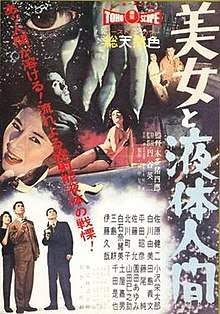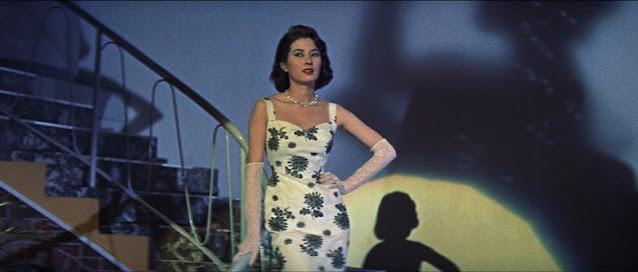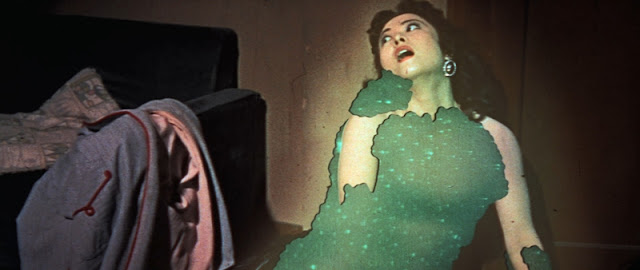(1958) Directed by Ishirô Honda; Written by Takeshi Kimura; Story by Hideo Unagami; Starring: Yumi Shirakawa, Kenji Sahara, Akihiko Hirata, Eitarô Ozawa Koreya Senda and Makoto Satô; Available on Blu-ray and DVD
Rating ***½
“Take a look at this logbook from the ship Ryujinmaru.
First, six men on deck fell victim to the radiation. The remaining men on the
ship fell, hopelessly, before their transformed shipmates. If any of the victim’s
psyches are preserved, it’s very possible that they tried to come to Tokyo. A liquid
organism created by an H-bomb test with the mind of a human. I suppose you
could call it an H-Man.” – Dr. Maki (Koreya Senda)
Although most film fans likely associate Ishirô Honda with his Showa era kaiju flicks, there’s a number of stand-alone titles in his filmography worthy of your attention. Upon its release in the U.S., The H-Man was unfairly maligned as a rip-off of The Blob. While both films debuted in 1958, Honda’s film actually predated the American movie by several months, and beyond some superficial similarities, differs widely in story and tone. Honda skillfully blends two strange bedfellows, film noir and science fiction, to create a unique experience.* Following the heels of Gojira (1954), The H-Man continues exploring the deleterious effects of radiation on humankind. Only 13 years after the catastrophic events in Hiroshima and Nagasaki, and with American atomic testing in the South Pacific in full swing, the threat of nuclear annihilation was fresh on the minds of the Japanese public.
* Fun Fact #1: the realistic street sets were recycled
from Akira Kurosawa’s Drunken Angel (1948)
When small-time criminal Misaki (Hisaya Itô) vanishes in
the middle of a drug deal, he leaves behind a pile of empty clothes and a big
mystery. While police inspector Tominaga (played by Akihiko Hirata, who
appeared as Dr. Serizawa in Gojira) takes a prosaic approach to the
evidence, professor Masada (Kenji Sahara) pursues a more fantastical
explanation for the disappearance. Both men are at odds with each other, as the
eager young Masada and the skeptical police official butt heads. Masada suspects
that there could be a link between Misaki and a fishing vessel that strayed
into a nuclear testing zone in the South Pacific. Tominaga and Masada seek out Misaki’s
girlfriend, nightclub singer Chikako Arai (Yumi Shirakawa), who might hold the
key to solving the puzzle.
Chikako serves as the film’s nominal femme fatale, although her character seems to promise more smolder than she delivers. She performs two English-language numbers at the nightclub, frequented by cops and criminals alike, but spends most of the movie badgered by the police, slapped around by two-bit hoods, or at the mercy of Masada and his lab team. Other times, she’s reduced to fainting at the appropriate moments (four times, by my count), although one could argue it’s a physiological reaction to radiation exposure. Chikako doesn’t share a lot of chemistry with Masada (okay, pun intentional), and Masada doesn’t really seem to be her type, but we’ll just take it on faith that their attraction transcends any preconceptions of compatibility.
Honda’s secret weapon in The H-Man was lighting technician Tsuruzô Nishikawa, whose bold lighting solutions contributed to the moody, shadow-filled look of the film. In the film’s best scene, told in flashback, a pair of hospitalized sailors recall their experience, exploring a seemingly abandoned fishing vessel. As they probe the eerie darkened corridors, illuminated by a solitary lantern, it gradually dawns on them that they’re not quite as alone as they once thought. The filmmakers are careful not to reveal too much all at once, letting our minds fill in the blanks about what lurks in the shadows. We’re left with one of the most memorable images, as the sailors gaze upon the decks of the derelict ship one last time, with its remaining occupants emitting a spectral green glow.
The H-Man is eye-opening in several respects, offering more for the viewer’s senses, compared to the rather chaste American genre output of the time. This is especially evident in the nightclub scenes, where dancers in skimpy outfits gyrate to jazz riffs. The film includes some suitably icky Grand Guignol flourishes, graphically depicting the unfortunate humans that come into contact with liquid entities. The effects are simple but effective, as bodies crumple and dissolve while they’re absorbed by green goo.* Another brief scene features a gunshot victim, replete with visible bloody bullet holes.
* Fun Fact #2: To create the goopy green slime, the filmmakers
employed a compound that was commonly used for cosmetic applications, made from
blue-green seaweed.
The H-Man* is best appreciated as an exercise in mood and style, rather than a full-blown crime movie. The mechanics of the plot prove to be little more than a red herring, designed to distract us from the film’s radioactive menace. The theme of body transformation and concept of an abandoned ship concealing a terrible secret would be explored (and arguably improved upon) several years later, with 1963’s Matango (also written by Takeshi Kimura), but H-Man’s slimy glowing adversaries stand out as a unique addition to the Toho sci-fi canon.
* Random thought: Considering the film’s drug-trafficking subplot, I suppose “H-Man” could also refer to heroin.
Source for this review: Ishiro Honda: A Life in Film, From Godzilla
to Kurosawa, by Steve Ryfle and Ed Godziszewski, with Yuuko Honda-Yun








Nice review, Berry!
ReplyDeleteI've heard The H Man, but I didn't know what it was about until now. The plot sounds really intriguing!
Plus, how can anyone go wrong with green goo.lol
LOL! Thanks! It's a unique, moody little film. And the effects are really cool. :)
DeleteShadowy urban landscapes, nightclub sequences, unseen menaces... this is sci-fi noir at its best! I remember this being one of a handful of movies that caused me some sleepless nights as a kid. One of the local TV stations showed sci-fi movies on Friday nights, and this was broadcast more than once. Speaking of overlooked Japanese sci-fi, have you seen The Invisible Man vs. the Human Fly from '57? Somewhat like H-Man, features a comic-book-like sci-fi premise with a noirish overlay.
ReplyDeleteHi Brian! I'm certain that if I had caught this on TV as a kid, it would've cause some sleepless nights as well. Such a great, atmospheric addition to Honda's resume. Not that I have anything against his many kaiju flicks, but I almost wish he did more in this vein. It's funny you should mention The Invisible Man vs. the Human Fly, since I plan to cover this soon. Stay tuned! :)
DeleteEureka have this on Blu Ray as a 2-disc with Battle in Outer Space, in their Masters of Cinema series. I'd heard bad things about H-Man but was very pleasantly surprised - a crossover between cop movie and SF/horror is a pretty good mix of genres. The effects are definitely better than I was led to believe, for a start! I'd recommend this - actually, I'd recommend it to someone who hasn't seen many (or any) Japanese films.
ReplyDeleteIt's a keeper! The effects are fun. I have the Mill Creek Blu-ray set with the same movies. I guess it must be a region thing (A vs B).
DeleteThis sounds right up my alley. You said it was available on Blu Ray. Looking at Amazon (Canada) I can only find a double feature disc with Battle in Outer Space. Is there a standalone disc out there somewhere?
ReplyDeleteI think you'd dig it. It's not perfect, but an interesting departure from Honda's kaiju fare. Unfortunately, I'm not aware of a standalone disc. I have the Mill Creek double-feature Blu-ray that you mentioned.
Delete